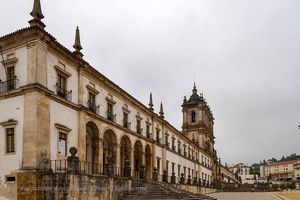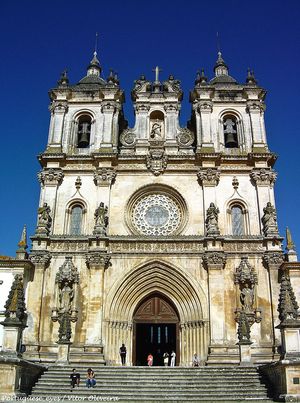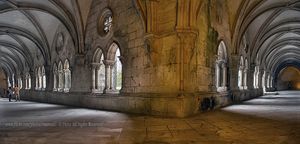
Monastery of Alcobaça
Visit the monumental Monastery of Saint Mary of Alcobaça in your journey to Portugal.
The Mosteiro de Santa Maria de Alcobaça (Monastery of Alcobaça) is for many the main reason to visit Alcobaça. Endorsed by the UNESCO, it was declared World Heritage.
It was founded in 1153 by D.Afonso Henriques, first Portuguese king, to fulfil a vow he had made to San Bernardo after recovering Santarém from the Moors in 1147. Once built, the king gave both the monastery and surrounding arable plots to the Cistercian monks.
It was finished in 1178, but monks weren’t installed until 1223, when the monastery had become in one of the richest and most powerful abbeys in Portugal. It is widely believed that 999 monks lived in the monastery in that time and that masses were constantly celebrated without a break.
Some monks changed from the agriculture to the education during the 13th century, using large property incomes to expand and modify the convent regarding the tendencies of the time. In the 17th century, some monks decided to offer their skills to ceramics and sculpture in stone and wood.
An agrarian revival took place in the 18th century, and the area of Alcobaça was one of the most productive ones in the country. However, more attention was drawn to the growing decadence and shortages experienced by monks, until 1834 in which religious orders were dissolved.
It’s worth to highlight the church, with the tombs of Dom Pedro and Dona Inés; the kitchen, the refectory, the Cloister of the Silence, and the Chamber of the Kings.
Church:
It is the first Gothic Portuguese church. Almost the whole facade was modified during the 17th and 18th centuries, except the main portico and the rose window which kept the former design.
It stands up for its large dimensions (106 m x 23 m) and its noticeable elegance, with great pillars and truncated columns. The construction was inspired in the French Cistercian abbey of Clairvaux.
The high altar is surrounded by a wide ambulatory with two 16th century beautiful Manueline gates and nine chapels embellished with wooden carvings of the 17th and 18th centuries.
It houses the 14th century tombs of Dom Pedro and Dona Inés in its transept. Two monuments in a flamboyant Gothic style, carved in soft limestone, that were designed in 1811 by the French soldiers of General Count Drouet d’Erlon.
Tomb of Inés de Castro:
Located in the left arm of the transept, it is supported by six angels. The lying sculpture rests on a tomb whose four sides are crowned by a frieze with the coat of arms of Portugal and the Castro Family’s one.
On the sides, there are scenes of Christ’s life; while on the head of the tomb, a crucifixion is exhibited where the Dolorosa is highlighted on the foot of the cross.
The surface of the feet is adorned by an interesting Last Judgement, where the deads are displayed while raising the stones of their tombs to attend to the judgement. To the right, the damned fall into the jaws of a monster that symbolises the hell.
Tomb of Dom Pedro:
It is located in the right arm of the transept of the church, under a lying statue. This tomb describes, in its sides, the life of Saint Bartolomé, patron saint of the king.
The head houses a beautiful rosette that represents the wheel of the fortune; while the opposite face is dedicated to the last moments of the king.
Cloister of the Silence:
This cloister, that seduces with its simplicity, was built in the early 14th century. Between the buttresses, some thin twin columns sustain elegantly the three arches crowned with a rosette. The upper floor was added in the 16th century by the well known architects Diogo and João del Castilho.
Kitchen:
It was rebuilt in the 18th century and is a monumental piece of 18 meters high covered with white ceramics. It has large chimneys and receives water directly from an arm of the river Alcoa.
Refectory:
It is a great pointed vault chamber. A carved stair in the interior of the wall and finished with a beautiful pillar leads to the pulpit of the reader. In front of the door, there is a basin with a 17th century font.
Chamber of the Kings:
It dates from the 17th century and is adorned with tiles that narrate the foundation of the monastery, and statues which represent the Kings, all made by the monks. It also exhibits a beautiful Gothic Virgin with the child.
More information:
Location:
Monastery of Saint Mary of Alcobaça, Alcobaça, Portugal.
Ticket Price:
Individual ticket: 6 €.
Combined entrance for the Heritage Trail (Ruta do Patrimonio which includes Alcobaça, Batalha, Convento de Cristo): 15 €
Free admission on Sundays and holidays until 14h00.
Opening Hours:
October through March from 9h00 to 17h00.
April through September from 9h00 to 19h00.
Closed the 1st of January, Easter Sunday, 1st of May and 25th of December.
Telephone:
(+351) 262 505 120
E-mail:
mosteiro.alcobaca@igespar.pt
Recommended Excursions:
Mapa Interactivo:
Alcobaça
What to see:
- Monastery of Alcobaça
- Castle of Alcobaça
- Pataias Lagoon
- Santa Maria de Cós Monastery
- Wine Museum of Alcobaça
- Bárrio Monographic Museum
- Raul da Bernarda Museum
Museums
Beaches:
Other worth-visiting nearby towns and cities:
Why "Portugal Travel"?
Portugal Travel is an organization of Portuguese agencies whose objectives are:
- ✓ To make Portugal, its culture and its heritage known.
- ✓ To promote sustainable tourism.
In collaboration with:
Escola Superior de Hotelaria e Turismo do Estoril
Turismo de Portugal
Copyright PortugalTravel.org © - All rights reserved.






